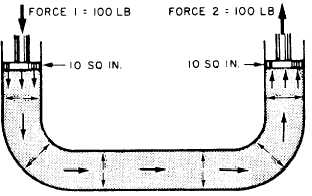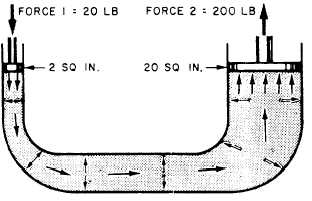LESS the friction head consumed in reaching that
point. Both velocity head and friction represent
energy that came from the original static head.
Energy cannot be destroyed. So, the sum of the
static head, velocity head, and friction at any
point in the system must add up to the original
static head. This, then, is Bernoulli’s principle;
more simply stated, if a noncompressible fluid
flowing through a tube reaches a constriction, or
narrowing of the tube, the velocity of fluid
flowing through the constriction increases, and
the pressure decreases.
When we apply a force to the end of a
column of confined liquid, the force is trans-
mitted not only straight through to the other
end but also equally in every direction through-
out the column. This is why a flat fire hose
takes on a circular cross section when it is
filled with water under pressure. The outward
push of the water is equal in every direction.
Water will leak from the hose at the same
velocity regardless of where the leaks are in
the hose.
Let us now consider the effect of Pascal’s
law in the systems shown in figure 2-14,
views A and B. If the total force at the
input piston is 100 pounds and the area of
the piston is 10 square inches, then each
square inch of the piston surface is exerting
10 pounds of force. This liquid pressure of
10 psi is transmitted to the output piston, which
will be pushed upward with a force of 10 psi.
In this example, we are merely considering
a liquid column of equal cross section so the
areas of these pistons are equal. All we have
done is to carry a 100-pound force around a
bend. However, the principle shown is the basis
for almost all mechanical hydraulics.
The same principle may be applied where the
area of the input piston is much smaller than the
area of the output piston or vice versa. In view
B of figure 2-14, the area of the input piston is
2 square inches and the area of the output piston
is 20 square inches. If you apply a pressure of 20
pounds to the 2 square-inch piston, the pressure
created in the liquid will again be 10 psi. The
upward force on the larger piston will be 200
pounds—10 pounds for each of its 20 square
inches. Thus, you can see that if two pistons are
used in a hydraulic system, the force acting on
each piston will be directly proportional to its
area.
A.
EQUAL INPUT AND OUTPUT AREA
B.
UNEQUAL INPUT AND OUTPUT AREA
Figure 2-14.—Principle of mechanical hydraulics. A. Equal
input and output area. B. Unequal input and output
area.
PRINCIPLES OF PNEUMATICS
PNEUMATICS is that branch of mechanics
that deals with the mechanical properties of gases.
Perhaps the most common application of these
properties in the Navy today is the use of
compressed air. Compressed air is used to
transmit pressure in a variety of applications. For
example, in tires and air-cushioned springs,
compressed air acts as a cushion to absorb shock.
Air brakes on locomotives and large trucks
contribute greatly to the safety of railroad and
truck transportation. In the Navy, compressed air
is used in many ways, For example, tools such
as riveting hammers and pneumatic drills are air
operated. Automatic combustion control systems
2-18




